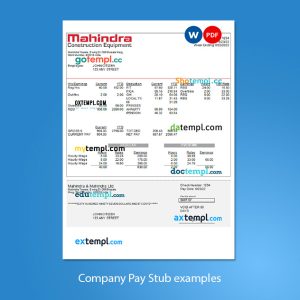What is a pay stub?
In today’s digital age, most companies have transitioned from manual to automated payroll systems, which has made it easier to generate pay stubs. Paystubs (or payslips) are important documents that provide a summary of an employee’s earnings and deductions for a particular pay period. They are usually issued to employees alongside their paychecks or deposited electronically into their bank accounts.
Paystubs contain vital information such as the employee’s name, address, Social Security number, pay rate, pay period, gross earnings, and net pay. They also include details of deductions made from the employee’s earnings, such as taxes, Social Security contributions, and health insurance premiums. Additionally, paystubs may include information about vacation and sick leave accruals, 401(k) contributions, and other benefits.
What is the main purpose of a pay stub?
The main purpose of paystubs is to provide a detailed breakdown of an employee’s earnings and deductions for a specific pay period. This document serves as a record of the employee’s income and can be used as proof of income for various purposes, such as applying for a loan, renting an apartment, or filing taxes.
Paystubs also help employees understand how their pay is calculated, including their gross pay, taxes withheld, and any other deductions made from their earnings. This information can help employees budget their finances and plan for future expenses.
For employers, paystubs serve as a record of payment made to employees, ensuring compliance with labor laws and regulations. They also provide a transparent breakdown of an employee’s earnings, helping to avoid any misunderstandings or disputes related to pay.
Overall, the main purpose of paystubs is to provide a clear and accurate record of an employee’s earnings and deductions, benefiting both employees and employers.
How to use a pay stub?
Pay stubs are important documents that provide a detailed breakdown of your earnings and deductions for a specific pay period. Here are the steps you can take to use a pay stub:
- Review the information: The first step is to review the information on your pay stub carefully. This includes your name, address, Social Security number, pay rate, pay period, gross earnings, and net pay. Make sure all the information is accurate.
- Check deductions: Your pay stub will also include information about deductions made from your earnings, such as taxes, Social Security contributions, and health insurance premiums. Make sure the deductions are accurate and match your expectations.
- Check vacation and sick leave accruals: If your employer provides vacation and sick leave benefits, your pay stub will include information about your accruals. Check to make sure the accruals match what you were expecting.
- Keep a record: It’s important to keep a record of your pay stubs for future reference. You can keep them in a file or folder, or scan them and keep a digital copy.
- Use for financial transactions: You can use your pay stub as proof of income for various purposes, such as applying for a loan or renting an apartment.
Overall, using a pay stub involves reviewing the information, checking deductions and accruals, keeping a record, and using it for financial transactions. Pay stubs are an essential tool for managing your finances and understanding your earnings and deductions.
Conclusion
In conclusion, pay stubs serve as important documents that provide employees with a detailed breakdown of their earnings and deductions for a specific pay period. By reviewing the information, checking deductions and accruals, keeping a record, and using them for financial transactions, employees can manage their finances effectively and understand their earnings and deductions. Pay stubs also help employers ensure compliance with labor laws and regulations and provide transparent documentation of payment made to employees. Overall, pay stubs are an essential tool for both employees and employers to maintain accurate records of earnings and deductions and promote a positive and productive working relationship.

